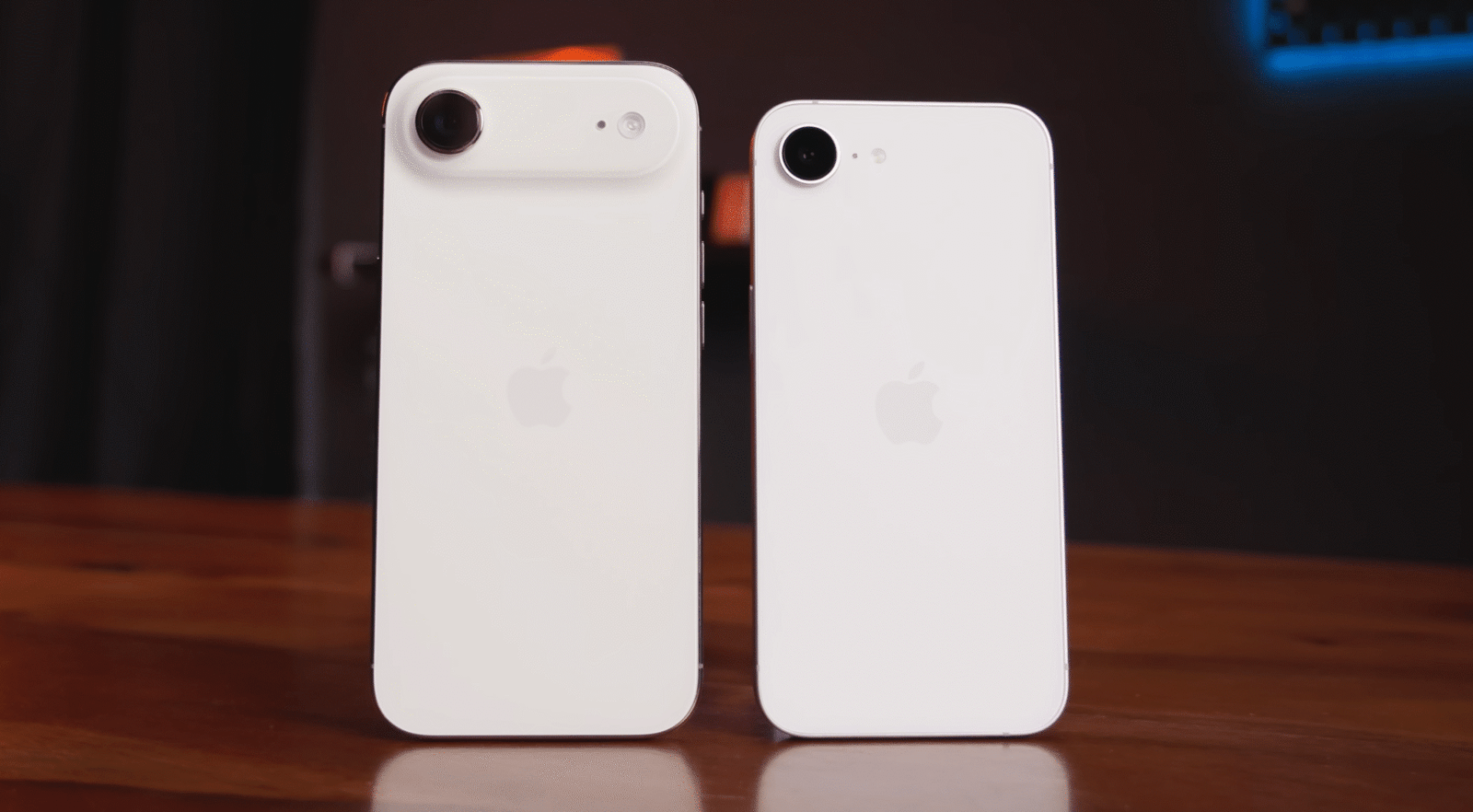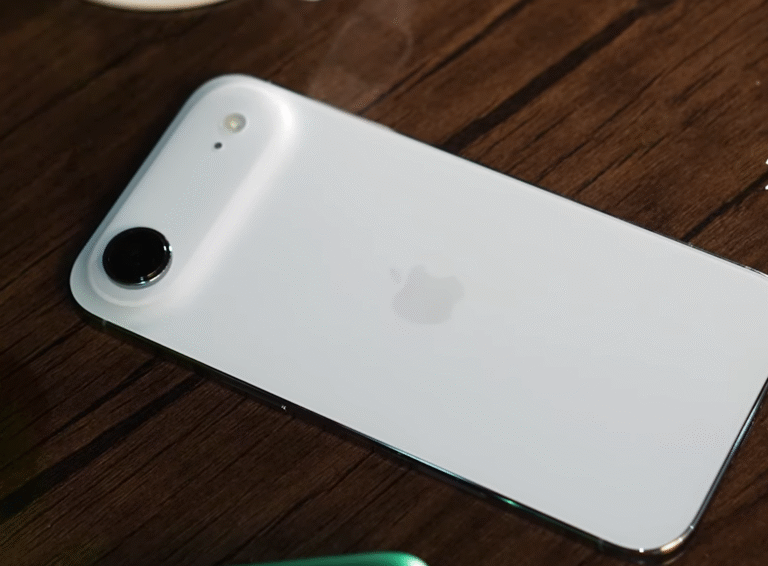
Apple’s latest lineup introduces the thinnest iPhone ever — the iPhone Air. Sleek, lightweight, and luxurious, it’s designed to turn heads. But right next to it stands the iPhone 16E, Apple’s more affordable, compact model that still delivers impressive performance.
So, the question is simple: Should you pay extra for the iPhone Air, or save a few hundred dollars and go with the 16E? Let’s break it down step by step — from design and display to cameras, performance, and battery — to help you decide which one truly fits your needs.
🧰 Design & Build
The first thing you notice when picking up the iPhone Air is its incredible thinness. It feels feather-light and sits comfortably in the hand thanks to its rounded corners. Its polished titanium frame adds a touch of luxury but is prone to fingerprints.
The iPhone 16E, on the other hand, has a more compact footprint with a matte aluminum frame and slightly sharper corners, making it easier to grip. Both models feature frosted glass backs, though only the Air gets Ceramic Shield protection on the rear.
In terms of weight, the Air is marginally lighter at 166g compared to the 16E’s 168g. Both are rated IP68, meaning they’re fully dust-tight and can survive underwater for up to 30 minutes at 6 meters — perfect if you accidentally drop your phone in water.
🌟 Display: Premium vs Practical
The iPhone Air offers a larger 6.5-inch OLED panel with LTPO technology and a buttery smooth 120Hz refresh rate, making scrolling and animations incredibly fluid. Peak brightness reaches 1,122 nits, making it easy to use even in harsh sunlight.
The iPhone 16E sports a 6.1-inch OLED display, but it’s limited to a 60Hz refresh rate and hits a lower 879 nits of brightness. It also keeps the classic notch, while the Air integrates Face ID inside the Dynamic Island.
Overall, the Air clearly wins in this category with better resolution, refresh rate, and outdoor visibility.
🔊 Audio: A Surprising Twist
You might expect the premium model to dominate in sound quality, but this is where things flip. The iPhone Air uses a single top speaker, while the 16E offers stereo speakers. The result? The 16E delivers richer, deeper bass and higher volume, easily outperforming the Air for casual music and video playback.
If audio quality matters to you, the 16E has the edge here.
📸 Camera Performance
Both phones come with a single 48MP main sensor, but the Air has the larger sensor. In daylight, photo quality is nearly identical — similar colors, sharpness, and detail. The 16E leans slightly cooler in white balance, but the difference is minor. Indoors, the Air produces cleaner images with less noise, while the 16E tends to pick up more grain.
In low-light scenarios, the Air pulls ahead with better shadow detail and reduced noise. Portrait shots also show the Air’s superior edge detection, especially at 2x zoom. Both models occasionally struggle with the blur effect disappearing in low light, but the 16E fails more often.
🎥 Video Recording
Both devices support up to 4K 60fps, but in real use, the Air offers superior stabilization. When walking, the 16E shows noticeable camera shake, while the Air remains smooth. Low-light video also looks better on the Air, with improved color accuracy and dynamic range. Neither phone includes cinematic video mode, which is a bit disappointing.
🤳 Front Camera
The iPhone Air introduces a new 18MP square sensor that makes it easier to switch between horizontal and vertical orientations. The 16E sticks with a 12MP sensor. The Air offers a wider field of view and captures more detail in low light.
For selfie video, both reach 4K 60fps with similar color reproduction and dynamic range — great for content creators and TikTok fans.
🧠 Performance & Benchmarks
Under the hood, the Air runs on Apple’s latest A19 chip, though it’s a slightly modified version with 5 GPU cores. It pairs with 12GB of RAM and starts at 256GB of storage.
The 16E runs on the A18 chip, has 8GB of RAM, and starts at 128GB of storage. On paper, the Air clearly leads, and in benchmarks, it scores around 200,000 points higher in AnTuTu.
However, real-world performance tells a more nuanced story:
-
In Lightroom exports, the 16E finished faster than the Air.
-
In gaming, both delivered solid frame rates, but the Air heated up more quickly, reaching 49°C during heavy sessions.
-
In Geekbench and 3DMark, the Air consistently outperformed the 16E, but everyday tasks felt nearly identical.
In short: the Air wins on benchmarks, but the 16E holds its own in actual use, sometimes even finishing tasks quicker.
🧭 Software Experience
Both phones ship with iOS 26.0.1, bringing Apple’s new Liquid Glass interface, enhanced personalization, updated camera UI, and Apple Intelligence features.
Apple doesn’t provide official update timelines, but historically you can expect around seven years of OS and security updates for both models.
From Circle-to-Search-like features to Image Playground with ChatGPT integration, both phones deliver the same software experience — so there’s no difference here.
🔋 Battery & Charging
Here’s a surprising twist: the iPhone Air has a smaller 3,149 mAh battery, while the iPhone 16E packs a 4,005 mAh cell. Despite this, both delivered similar real-world battery life, with the Air performing slightly better thanks to its LTPO display.
Charging speeds tell a different story. Using a 100W charger:
-
The 16E charged fully in 1h 34m, peaking at 25W
-
The Air took 1h 44m, peaking at 19W
Wireless charging is another big difference: the Air supports 20W MagSafe, while the 16E is stuck at 7.5W and doesn’t support MagSafe at all.
💰 Pricing: The Deciding Factor
Here’s where the gap becomes clear:
-
iPhone Air: $999
-
iPhone 16E: $599
That’s a $400 difference — enough to buy another gadget, or a mountain of Snickers bars.
🟢 Final Verdict
If you prioritize looks, display quality, and slightly better camera performance, the iPhone Air is an elegant choice. Its build, screen, and benchmarks are impressive.
However, if you want excellent value, compact size, better audio, and nearly identical day-to-day performance, the iPhone 16E is the smarter buy. For $400 less, you’re giving up surprisingly little.
Apple could have made the Air a true standout by adding an ultrawide lens or cinematic video, but as it stands, the Air mainly sells on aesthetics — not massive feature differences.



